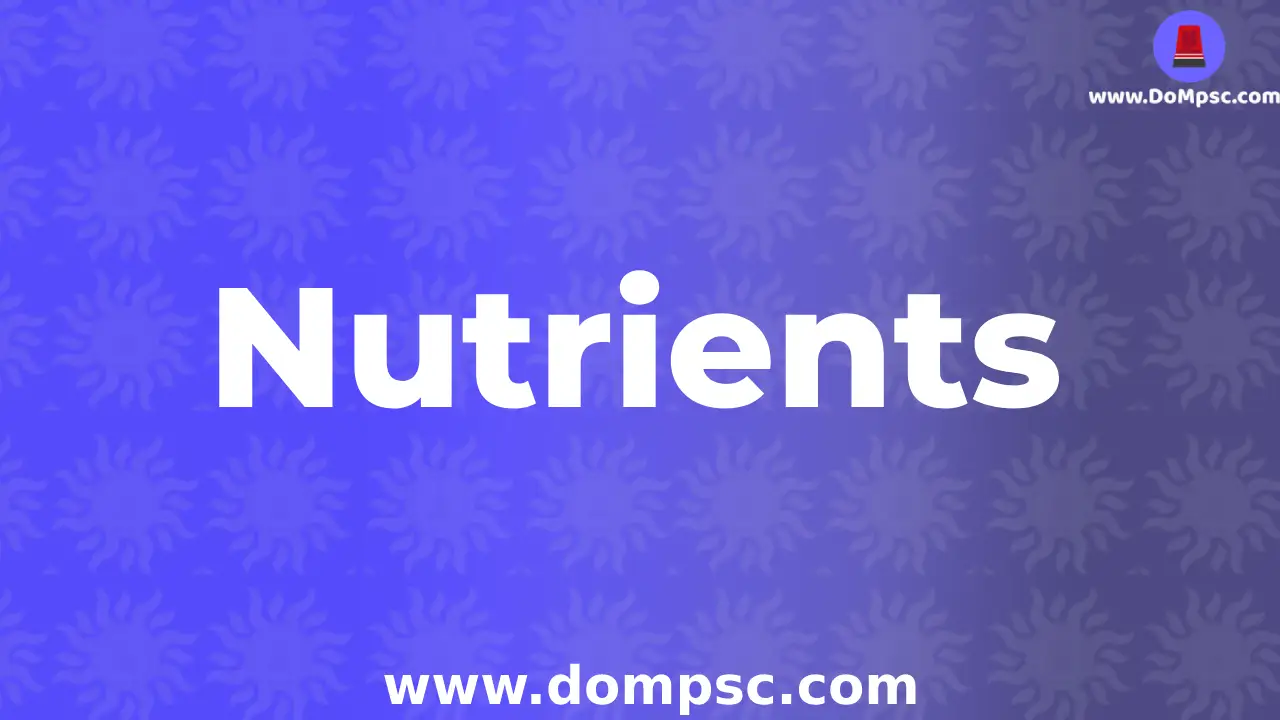MPSC Nutrient(पोषण)-MPSC Biology science notes
Nutrient(पोषण)
Table Of Contain-Mpsc Nutrient(पोषण)
✪ Download pdf Works Properly on chrome Browser ✪

Introduction of Nutrient(पोषण)

By Shubham Vyawahare
18-September-2025
➤ So to work a factory well there should be a need of good department and department mangers .
➤ Like That Human Body has a need of good substances which perform a all task.
➤ This perform separate cycle in human body structure.
➤ Human have to depends on other for nutrients.
➤ Nutrients are compounds in foods essential to life and health, providing us with energy, the building blocks for repair and growth and substances .
➤ This substances necessary to regulate chemical processes in our body.
✪ Types of Nutrient ✪
✪ Major Components ✪
1.Carbohydrates
➤This is structure of item which is made up of a Carbon hydrogen and oxygen. ➤Water soluble carbohydrates are know as as sugar.
➤ It Gives maximum energy which require for body process.
➤ Three main types of carbohydrate in food-Starches,Sugars,Fiber.
➤ Carbohydrates perform numerous roles in living organisms.
➤ Carbohydrates are central to nutrition and are found in a wide variety of natural and processed foods.
➤Types OF Carbohydrates
➤ Monosaccharides, also known as monosaccharides, are the simplest form of sugar and the most basic carbohydrate unit Found in a Human Body.
➤ Examples are glucose (dextrose), fructose (levulose), and galactose.
➤ The monosaccharide glucose plays a key role in metabolism. In the metabolism, chemical energy is extracted through glycolysis and citric acid cycle to provide energy for organisms.
➤ CnH2nO is The Basic for of a monosaccharides. Di-saccharides
➤It includes 2 molecule of a sugar.
➤ Maltose.
➤ Glucose.
➤ Lactose.
Poly-saccharides
➤It includes 100 to 1000 molecule of a sugar.
➤ Starch.
➤ Dexedrine.
➤ Pectic Substances.
Sources:Dairy,Milk, yogurt, and ice cream. Fruit, Whole fruit and fruit juice, Grains, Bread, rice, crackers, and cereal, Legumes, Beans and other plant-based proteins, Starchy Vegetables. Potatoes and corn, Sugary Sweets, Limit these.
Proteins
➤ Proteins are the made up of a amino acids.
➤ they are the main components which required to increase our immunity systems.
➤ Protein is made up with a chain of Carbon hydrogen nitrogen and oxygen.
➤ In our body there are only 21 amino acids are presents.
➤ Enzymes and hormones are made up with a proteins
➤ 10% to 12 % of energy is made up of a proteins.
✪ Some properties of a proteins ✪
1.Denaturation:-Denaturation is a process in which proteins or nucleic acids lose their natural quaternary structure, tertiary structure and secondary structure by applying certain external stress or compounds (such as strong acids or bases, concentrated inorganic salts) Organic solvents.
2.Coagulation:-Coagulation, otherwise called thickening, is the procedure by which blood changes from a fluid to a gel, framing a blood coagulation. It possibly brings about hemostasis, the suspension of blood misfortune from a harmed vessel, trailed by fix.
3.Emulsification:An emulsion is a blend of at least two fluids that are regularly immiscible attributable to fluid stage detachment. Emulsions are a piece of a more broad class of two-stage frameworks of issue called colloids .
3.Foaming:The fundamental capacity of proteins in froths is to diminish interfacial pressure, to build gooey and versatile properties of the fluid stage and to shape solid movies.
Sources of a Proteins: beef, lamb, veal, pork, kangaroo chicken, turkey, duck, emu, goose, bush birdsfish, prawns, crab, lobster, mussels, oysters, scallops, clamsmilk, yoghurt (especially Greek yoghurt), cheesealmonds, pine nuts, walnuts, macadamias, hazelnuts, cashews, pumpkin seeds, sesame seeds, sunflower seedsall beans, lentils, chickpeas, split peas.
Fats
➤ They are in the form of setrioid and glisrol.
➤ Fat usually provides more than half of the energy needed by the body.
➤ The molecule is mainly composed of carbon and hydrogen atoms, so it is hydrophobic, soluble in organic solvents, but insoluble in water
➤ support cell growth
➤Triglycerides, cholesterol and other essential fatty acids-scientific terms for fats that the body cannot produce on its own-store energy
➤Triglycerides, cholesterol and other essential fatty acids-scientific terms for fats that the body cannot produce on its own-store energy
Fats Sources:Red meat (beef, lamb, pork) Chicken skin,Whole-fat dairy products (milk, cream, cheese),Butter,Ice cream, Lard.,Tropical oils such as coconut and palm oil.
Vitamins
➤ Vitamin is an organic molecule and an essential micro nutrient. The organism needs a small amount of this micro nutrient to perform its metabolic function normally.
➤ Casimir Funk is a discoverer of vitamins, He discovered vitamins in 1912.
➤ Vitamins help support bones, heal wounds and maintain your immune system.
➤ Vitamins also convert food into energy.
➤Vitamins help repair cell damage.
Vitamin A
| Chemical Name | Ratinol |
|---|---|
| Source | Tomato,Carrot,Mango,Milk,curd,Eggs |
| Function | Immunity systems,Growth of a body,Increase eye sight,teeth,skin. |
| Efficiency Diseases | Night Blindness,Xerophthalmia,Bitots spot. |
Vitamin C
| Chemical Name | Ascorbic Acid |
|---|---|
| Source | Lemmon,Orange,Pineapple,grapes,tomato,cabbage. |
| Function | To Fight with diseases,Blood Clotting,Helps in skin health |
| Efficiency Diseases | scurvy,calcium,Kidney Stone |
Vitamin D
| Chemical Name | Calciferous |
|---|---|
| Source | Human Body,Fresh sun rays. |
| Function | To provide strength for a bones,Develop Teeth and bones. |
| Efficiency Diseases | Rickets,Osteomalacial,Hypercalemia |
Vitamin E
| Chemical Name | Tocopherol |
|---|---|
| Source | Oils. |
| Function | ANtioxident,Helps in immunity systems. |
| Efficiency Diseases | loss of body movement control muscle, weakness vision problems. |
Vitamin K
| Chemical Name | Phylloquinone |
|---|---|
| Source | Milk,Cabage,Liver,Eggs,. |
| Function | Work in Blood Clotting,Development of bones,Glucose Development. |
| Efficiency Diseases | Blood Clotting Speed Decreases. |
Minerals
➤Minerals are chemical elements necessary for living organisms to perform functions necessary for life.
➤They are Found in a form of a salt.
➤ Basically they are require to possible growth of a body.
➤ control body fluids inside and outside cells.
➤ turn the food we eat into energy..
| Name | Work | Source |
|---|---|---|
| Sodium | Needed for proper fluid balance, nerve transmission, and muscle contraction | Table salt, soy sauce; large amounts in processed foods; small amounts in milk, breads, vegetables, and unprocessed meats |
| Chloride | Need proper water balance, stomach acid | Salt, soy sauce; large amounts of processed food; small amounts of milk, meat, bread and vegetables |
| Potassium | Requires proper fluid balance, nerve transmission and muscle contraction. | Meats, milk, fresh fruits and vegetables, whole grains, legumes. |
| Calcium | It is important for healthy bones and teeth; it helps muscles relax and contract; it is important for nerve function, blood clotting, blood pressure regulation, and immune system health. | Milk and dairy products; canned fish with bones (salmon, sardines); fortified tofu and fortified soy milk; vegetables (broccoli, mustard); beans. |
| Phosphorus | Important for healthy bones and teeth; found in every cell; part of the system that maintains acid-base balance. | Meat, fish, poultry, eggs, milk, processed foods (including soda pop). |
| Magnesium | Found in bones; needed for making protein, muscle contraction, nerve transmission, immune system health. | Nuts and seeds; legumes; leafy, green vegetables; seafood; chocolate; artichokes; "hard" drinking water. |
| Sulfur | Found in protein molecules. | Occurs in foods as part of protein: meats, poultry, fish, eggs, milk, legumes, nuts. |
| Iron | Part of a molecule (hemoglobin) found in red blood cells that carries oxygen in the body; needed for energy metabolism. | Organ meat; red meat fish; poultry; shellfish (especially clams); egg yolks; beans; dried fruits; dark green leafy vegetables; iron-rich breads and cereals; and fortified cereals. |
Others Blogs Related to MPSC Biology Notes
➤Biology Exam Pattern
➤Blood Circulation System
➤Blood Groups And Its Diseases
➤Balanced Diet And Nutrients
➤Classification Of Animals
➤Classification OF Plants
➤Cell
➤Tissue
➤Coordination In Human
➤Digestive System
➤Diseases And Disease Types
➤Excretory System
➤Respiratory System
➤Reproductive System
➤Skeletal System
Read All MPSC blogs
- ➤केंद्र सरकारने खाजगी क्लासेस साठी नवी नियमावली लागू केली आहे |GUIDELINES FOR REGULATION OF COACHING CENTER in marathi
- ➤MPSC Data leak: पेपर न फुटल्याचा दावा MPSC आयोगाने स्पष्टपणे केला आहे
- ➤MPSC hall ticket data leaked before 6 days of exam
- ➤MPSC Data leak: टेलेग्राम वर अचानक ९० हजार परीक्षार्थींचे प्रवेशपत्र झाले लिक
- ➤मराठी भाषेला अभिजात दर्जा मिळायला हवाच , अभिजात दर्जा नेमका कसा मिळतो ?
MPSC Books pdf



